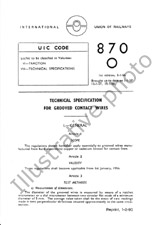We need your consent to use the individual data so that you can see information about your interests, among other things. Click "OK" to give your consent.

UIC 751-3-4ed.
Technical regulations for international ground-train radio systems
STANDARD published on 1.7.2005
The information about the standard:
Designation standards: UIC 751-3-4ed.
Publication date standards: 1.7.2005
SKU: NS-550395
The number of pages: 63
Approximate weight : 189 g (0.42 lbs)
Country: International technical standard
Category: Technical standards UIC
Annotation of standard text UIC 751-3-4ed. :
Summary:
maryThis leaflet contains technical regulations for ground-train radio systems in international traffic.
It defines the scope of the leaflet, describes operating modes plus minimal technical specifications.
Detailed provisions ensuring quality of communications are also given, with emphasis on: location of fixed installations, radio coverage, technical transmission/reception characteristics, fixed and mobile aerials, operating modes, quadri-frequency sets, auto-switching of mobile-set frequencies, cable links, loudspeakers and tractive-unit micro-telephone sets.
The leaflet then defines the frequency chart: setting-up and allocation of channels, joint frequency bands, distance between channels, duplex channels, numbering of channels, intermodulation, preferential channels, switchable channels and simplex channels aboard tractive units.
The different radio-control processes are also described: idle mode, connections, operating provisions and warning procedures.
The corresponding command signals are explained in detail.
Links between motive power unit and RIC coaches together with the corresponding communications between drivers, central control and train staff are explained in specific terms.
Finally, the leaflet describes the special features of the ground-to-train radio system with selective call and message transmission by digital code, as well as those of the radio-telephony system with simultaneous transmission of digital messages.
Name:Technische Vorschriften für Analog-Zugfunksysteme im internationalen Dienst
Zusammenfassung: Vorliegendes Merkblatt enthält die technischen Bestimmungen für Zugfunksysteme im internationalen Dienst. Es erläutert den Gültigkeitsbereich, die Betriebsarten sowie die technischen Mindestbedingungen. Die Bestimmungen gewährleisten die Voraussetzungen für eine gute übertragungsqualität im Hinblick auf: die Anordnung der Streckenfunkstellen, die Funkversorgung, technische Sende- und Empfangsmerkmale, Strecken- und Fahrzeugantennen, Betriebsarten, Viererfrequenzgruppen, automatische Frequenzumschaltung der beweglichen Empfänger, Verbindungsleitungen, Lautsprecher und Sprechhörer in den Triebfahrzeugen. Das Merkblatt legt den Frequenzplan fest: Erstellung, Zuteilung der Kanäle, gemeinsame Frequenzbänder, Abstand der Kanäle, Duplexkanäle, Nummerierung der Kanäle, Intermodulation, Vorzugskanäle, schaltbare Kanäle, und Simplexkanäle bei Triebfahrzeuggeräten. Es erläutert die Steuerung der Funkverbindung: Freizustand, Anschaltung, Bestimmungen zu den Betriebsarten sowie dem Notsignal. Die entsprechenden Steuersignale werden ebenfalls dargelegt. Die Verbindungen zwischen Triebfahrzeugen und RIC-Reisezugwagen sowie die entsprechenden Sprechverbindungen zwischen Triebfahrzeugführer, Funkzentrale und Zugbegleitpersonal werden gesondert ausgeführt. Abschließend beschreibt das Merkblatt die besonderen Merkmale des Zugfunksystems mit selektivem Ruf und die Nachrichtenübertragung mit numerischem Code sowie die Merkmale des Zugsprechfunksystems mit gleichzeitiger übertragung von digitalen Meldungen.
We recommend:
Technical standards updating
Do you want to make sure you use only the valid technical standards?
We can offer you a solution which will provide you a monthly overview concerning the updating of standards which you use.
Would you like to know more? Look at this page.



 Cookies
Cookies
